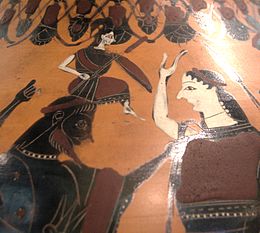 |
| http://www.talesbeyondbelief.com/greek-gods/zeus.htm |
I wrote the beginning of Egypt's gods, godesses, and Egypt's myth
here. Now, I'm going to tell you about the myth of the beginning of Greek's gods and godesses. The story was told before writing was made, so it was passed down orally, and sometimes the story got mixed up. Greece has many places, such as Athens, Sparta, and Olympia (that's well known for the place where the gods dwell), and if people from those places meet together and retell the story, all of them will be confused. Some people will say "Leto is Zeus's wife", while some say "No! Hera is Zeus's wife." In the ancient times, man used to have many wives, with the first as the chief wife, so finally it was concluded that Zeus had many wives, and it was known that Hera was the chief wife.
Let's Start.
First, there was chaos all around. Then night and Erebus (darkness) were born, where death dwells. From them, love was born, Love created light and day. The first creatures born from it were Gaia (mother Earth) and Uranus (father Heaven). They had children who were the Hechatocheires ( monsters with fifty heads) , Cyclopses, and Titans. There were many Titans, and one of the Titans was Kronos. Kronos looked really gigantic (as how Titans did) and had a sickle, and with that sickle he wounded his father Uranus. From Uranus's blood that spilt into the land, there formed the giants and also his blood that spilt into the sea formed Aphrodite. Below was Kronos wounding Uranus.
 |
| http://www.the-dreamweaver.net/portal/en/articles/2-uncategorised/41-the-cycles-of-saturn-and-uranus |
After that, Kronos ruled the world and married his sister Titan Rhea. His parents told him that one of his children would dethrone him, as how he dethroned his father. So, everytime his child was born, he would eat them. His children were: Hera, Demeter, Hades, Poseidon, Hestia, and Zeus. But all of them were eaten by Kronos, except Zeus, whom Rhea hid in a cave in Crete with the nymphs there to take care of him. Mother Earth Gaia also took care of him. The other smaller gods and soldiers clanged their swords when Zeus cried, so that Kronos would not hear Zeus's cry. After Zeus was hidden, Rhea wrapped a stone with baby clothes and gave it to Kronos to eat, making Kronos think that he had eaten Zeus.
Zeus grew up into an adult there, and with the help of a good Titaness Metis (or thought) who created a poisonous drink, made his father Kronos to vomit out all of his siblings. Then with the help of the Cyclops, (giants with one eye in the middle of the forehead), ten years Zeus and all of the inhabitants fought, and finally Zeus managed to put Kronos and the bad Titans in a prison under the earth called Tartarus.
 |
| http://atlanteangardens.blogspot.com/2014/04/war-of-gods-and-titans.html |
Only, not all Titans fought and not all Titans were bad. The sea itself was a Titan, and others too, who were kind and really helpful, such as Selene, the moon, and even Metis was a Titan, which we will discuss later. There were some other Titans too. The kind Titans who helped them were not put into Tartarus.
One of the Titan that was sent down to Tartarus had three sons, Atlas, Prometheus, and Epimetheus. Atlas was as wicked as his father, and he really looked like a Titan, so Zeus punished him by making him carry the world on his back (because he's wicked), while the other two would help Zeus manage the land.
In the middle of the battle, Zeus fell in love with Metis, but he heard that the child that Metis would have would overpower him. Metis could change into any form, and Zeus tricked her to change into a fly. Then Zeus swallowed her. Eventually, he got a terrible headache, and asked someone to cut his head (Gods couldn't die) and out came Athena fully armed with clothes, a shield, and a spear. But she had no notion of overpowering her father. That's why in friezes, you can see Athena fighting the Titans. She killed a bad Titan named Pallas, and added his name into hers, so her name became Pallas Athena. Below is the picture of Athena coming out of Zeus's head on an ancient Greek pot.
 |
| https://en.wikipedia.org/wiki/Athena |
 |
| https://www.studyblue.com/notes/note/n/arth-exam-2/deck/10710897 |
And this is Athena fighting the titans. The head was stolen.
After the battle was won, they decided who would rule the air, the sea, and the rest. So it was decided that Zeus would rule over the whole Gods, Hades over the Underworld, Poseidon over the Sea, Hera (Zeus's wife) as the protector of women and marriage, Hestia, the goddess of the hearth, as hearth was very important to the Greeks, because fire was really important back then, and Demeter, the goddesss of the harvest.
That's the end of the myth.

 Today was my youngest cousin's birthday. She lives in Malaysia. The party was located by the sea in Bandar Jakarta Baywalk Mall.
Today was my youngest cousin's birthday. She lives in Malaysia. The party was located by the sea in Bandar Jakarta Baywalk Mall.

































































